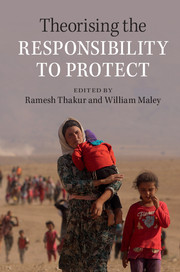Book contents
- Frontmatter
- Contents
- List of figures
- Notes on contributors
- Part I Context
- 1 Introduction: theorising global responsibilities
- 2 The evolution of the Responsibility to Protect: from concept and principle to actionable norm
- 3 From the right to persecute to the Responsibility to Protect: Feuerbachian inversions of rights and responsibilities in state–citizen relations
- 4 The Responsibility to Protect and a theory of norm circulation
- Part II The Responsibility to Protect, normative theory and global governance
- Part III The Responsibility to Protect and international social purposes
- Index
2 - The evolution of the Responsibility to Protect: from concept and principle to actionable norm
from Part I - Context
Published online by Cambridge University Press: 05 August 2015
- Frontmatter
- Contents
- List of figures
- Notes on contributors
- Part I Context
- 1 Introduction: theorising global responsibilities
- 2 The evolution of the Responsibility to Protect: from concept and principle to actionable norm
- 3 From the right to persecute to the Responsibility to Protect: Feuerbachian inversions of rights and responsibilities in state–citizen relations
- 4 The Responsibility to Protect and a theory of norm circulation
- Part II The Responsibility to Protect, normative theory and global governance
- Part III The Responsibility to Protect and international social purposes
- Index
Summary
In its conception, birth and growth to maturity – and what may be now its mid-life crisis – the Responsibility to Protect (R2P) has been, at least in the eyes of its progenitors, much less about theorising than action. The focus from the outset was on practical impact. Our perception was that whatever else went wrong in the conduct of international relations, the world could no longer afford to mishandle its collective response to genocide and other mass atrocity crimes. We saw a new conceptual framework for addressing these issues, built on sound legal and philosophical foundations, as a crucially necessary ingredient. But the point of crafting it was above all political – to energise effective collective action by generating a new consensus reflex among international policymakers and those who influenced them to view man-made human rights catastrophes, when any such new case arose, as everybody's business, not nobody's.
Challenge
Achieving such a new consensus was a huge challenge. It is almost impossible to overstate the extent to which there had been an absence of consensus on these issues in the past. In pre-modern – including biblical – times, mass atrocities seem to have been a matter of indifference to everyone but the victims. With the emergence of the modern system of nation states in the seventeenth century, that indifference simply became institutionalised: sovereign states did not interfere in each other's internal affairs. Certainly, there were instances in the nineteenth century of European states intervening in various corners of the Ottoman Empire to protect Christian minorities at risk; however, there was no generally accepted principle in law, morality or state practice to challenge the core notion that it was no one's business but their own if states murdered or forcibly displaced large numbers of their own citizens, or allowed atrocity crimes to be committed by one group against another on their soil.
Even after the Second World War, with the awful experience of Hitler's Holocaust; the recognition of individual and group human rights in the UN Charter and, more grandly, in the Universal Declaration of Human Rights; the recognition by the Nuremberg Tribunal Charter in 1945 of the concept of ‘crimes against humanity’; and the signing of the Genocide Convention in 1948, things did not fundamentally change.
- Type
- Chapter
- Information
- Theorising the Responsibility to Protect , pp. 16 - 37Publisher: Cambridge University PressPrint publication year: 2015
- 7
- Cited by



